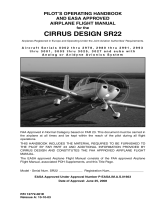
ATR 42 190-01616-03 Rev. 2
FAA APPROVED
Page 16 of 35
NOTE
Navigation database discrepancies can be reported at FlyGarmin.com then select “Aviation
Data Error Report”. Flight crew and operators can view Navigation data base alerts at
FlyGarmin.com then select “NavData Alerts”.
6. For flight planning purposes, IFR operations in areas where SBAS coverage is not available
along the entire route of flight, the flight crew must check FDE/RAIM availability.
7. For flight planning purposes, IFR operations within the U.S. National Airspace System on RNP
and RNAV procedures when SBAS signals are not available, the availability of GPS integrity
FDE/RAIM shall be confirmed for the intended route of flight. In the event of a predicted continuous
loss of RAIM of more than five minutes for any part of the intended route of flight, the flight should be
delayed, canceled, or re-routed on a track where FDE/RAIM requirements can be met. The flight may
also be re-planned using non-GNSS based navigational capabilities.
8. For flight planning purposes, for operations within European B-RNAV and P-RNAV airspace, if
more than one satellite is scheduled to be out of service, then the availability of GPS integrity
FDE/RAIM shall be confirmed for the intended flight (route and time). In the event of a predicted
continuous loss of FDE/RAIM of more than five minutes for any part of the intended flight, the flight
should be delayed, canceled, or re-routed on a track where FDE/RAIM requirements can be met.
9. For flight planning purposes, IFR operations where the route requires Class II navigation the
aircraft’s operator or flight crew must determine that FDE/RAIM will be available along the
intended route. Use the Garmin WFDE Prediction program to determine that there are no outages
on the specified route that would prevent the G1000 from providing primary means of Class II navigation
in oceanic and remote areas of operation that requires (RNP-10 or RNP-4) capability. If the Garmin
FDE Prediction program indicates fault exclusion (FDE/RAIM) is unavailable for more than 34 minutes
in accordance with FAA Order 8400.12C for RNP-10 requirements, or 25 minutes in accordance with
FAA Order 8400.33 for RNP-4 requirements, then the operation must be rescheduled when FDE/RAIM
is available.
10. Two GTN 725 units and two EHSI navigation displays must be operating and providing GPS
navigation guidance for operations in the following airspace:
• RNP-4 (except for operations where single long range navigation system is authorized)
• RNP-10 (except for operations in the Gulf of Mexico where single long range navigation
system RNP-10 is authorized)
• NAT MNPS (except routes requiring only one long range navigation system)
• Oceanic/Remoter Areas (Class II navigation) (except routes requiring only one long range
navigation system)
11. Manual entry of waypoints using latitude/longitude or place/bearing is prohibited for RNP and
RNAV routes. This includes Standard Instrument Departures (SIDs) and Obstacle Departure
Procedures (ODPs), Standard Terminal Arrival (STAR), and enroute (including RNAV “Q” and RNAV
“T” routes). Whenever possible, RNP and RNAV routes should be loaded into the flight plan from the
database in their entirety, rather than loading route waypoints from the database into the flight plan
individually. Selecting and inserting individual named fixes from the database is permitted for
procedures not contained in the navigation database. In such cases, route waypoints can be loaded
into the flight plan by selecting and inserting individual named fixes from the database provided all fixes
along the published route to be flown are inserted.























